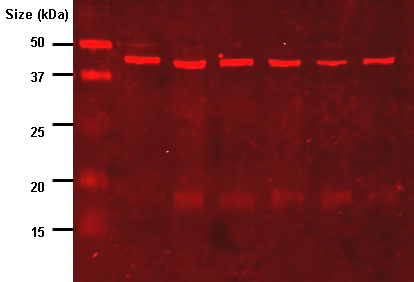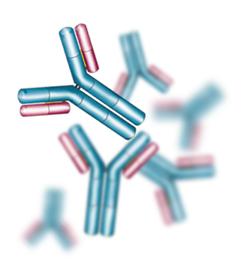Antibodies, or immunoglobulin molecules, are an important part of the immune system, facilitating cellular and humoral reactions to various types of antigens. Most antibodies produced are polyclonal, resulting in slight variations in specificity for a target antigen that causes the antibodies to bind to different regions of the antigen or the same region with different affinities. The polyclonality of antibodies indicates that they are produced by numerous distinct B cell lymphocytes in the immune system; however, it is also possible to produce larger quantities of a single type of antibody from one B cell clone as well. This latter type is called a monoclonal antibody.
Many types of monoclonal antibodies have been developed over the years as potential drug treatments for different immunologic diseases, reversal of drug effects, and cancer therapies. There are several approaches for creating these antibodies with specific targets, with immunization of an animal as one of the most popular methods. This involves immunizing a specific animal, typically a rabbit or mouse, with the target antigen. B cell candidates that produce antibodies for this antigen are then harvested from the spleen cells of the animal. Once a monoclonal antibody with the desired specificity is obtained, it can then be produced in large quantities and used as treatment therapies. It is not uncommon to require several grams of monoclonal antibodies for adequate treatment of one patient.
Because these monoclonal antibodies are created in animals, there is a risk of the patients developing an immune response against the rabbit/mouse derived antibodies. Once antibodies have been developed against these monoclonal antibodies, they can no longer be used as treatment options for those patients. To prevent this from occurring, these monoclonal antibodies can be “humanized” by engineering amino acid substitutions using recombinant DNA protocols, making them more similar to human sequences. These humanized monoclonal antibodies are also called recombinant antibodies.
Monoclonal antibodies can be further modified to have functions that are even more specific. Some examples include the following:
- Bifunctional antibodies. These types have two immunoglobulin chains with differing specificity fused together, allowing the antibody to bind to and bring two different antigens in close proximity. This can allow for new functions to be carried out, such as engaging immune cells with tumor cells.
- Drug or toxin conjugation. For this method, drugs or toxins are attached to the immunoglobulin chain using covalent binding (which prevents early dissociation). The monoclonal antibody can then be used to deliver the drug or toxin to a specific site, allowing it to kill cells in a cancer therapy or enact an antimicrobial effect.
- Antigenized antibodies. This is an investigational method where monoclonal antibodies are engineered to deliver an antigen. This involves replacing part of the antibody polypeptide with a fragment of the antigen, allowing them to be potentially used as vaccines. These antigenized monoclonal antibodies have a longer serum half-life and may be better tolerated than some isolated antigen fragments; however, this potential technology has not yet advanced beyond animal studies.
- Fc region engineering. The Fc region of an antibody is considered the “constant fragment”. While the variable fragment, Fab, mediates antigen binding, the Fc region mediates effector functions via interaction with Fc receptors on immune cells or with C1q (which is part of the complement system). Binding to the Fc receptors on immune cells can lead to their activation, such as increased production of cytokines or phagocytosis of antibodies, while binding to C1q will activate the classical pathway of the complement cascade. The Fc region can also influence the half-life of antibodies, particularly in IgGs. Some examples of modifications include engineering Fc regions to increase specificity for receptors on certain subpopulations of cells, or to promote binding of neonatal Fc receptors (FcRn) to increase the half-life of IgGs by promoting their recycling. Attention has also been placed on the glycosylation of the Fc region and its influence on effector functions and half-life.
One key attribute of monoclonal antibodies is their affinity of the target antigen, which is determined by their complementarity-determining region, or CDR. Antibodies with the greatest affinities to these locations are chosen for studies. Another key attribute is their ability to recruit other immune cells, which is important for killing targeted cells. Potential targets for monoclonal antibodies can include the following:
- Cell surface antigen. The monoclonal antibody can be directed against a cell surface antigen, possibly to block its function or initiate a signalling cascade to kill the target cell.
- Plasma protein or drug. This method can sequester proteins or drugs away from their normal binding partners. Being bound to the monoclonal antibody prevents them from interacting with their targets and essentially neutralizing them. These proteins or drugs will then be cleared from the body by macrophages.
- IgG receptor. Reducing the length of time that IgG antibodies circulate in the body can help treat autoantibody-mediated disorders. Targeting the FcRn binding site can inhibit its mechanism to increase IgG half-life in circulation, thereby inhibiting IgG transcytosis and their reuse.
- Infectious organism. This method is an area of research still under investigation. The mechanism of action of these monoclonal antibodies would be similar to that of the natural humoral immunity, however the method of microbe elimination is not entirely understood. Potential uses would involve targeting the proteins on the microbe cell surface, by either triggering cell death or preventing entry into the host cells.
Boster Bio is a company that specializes in discovering rabbit recombinant monoclonal antibodies with high affinity and specificity tailored to the desired functionality. They have been highly successful in developing rabbit monoclonal antibodies for difficult antigens with their patented microfluidics plasma cell discovery (PCD) platform, which allows for reduced screen time by beginning with the process of isolating antigen-specific plasma cells to ensure a larger selection of high affinity antibodies. For more information, check out their Custom Rabbit Monoclonal Antibody Discovery Service.

References:
Bakhtiar, R. (2016). Antibody drug conjugates. Biotechnol Lett, 38(10), 1655-64.
Bruhns, P. (2012). Properties of mouse and human IgG receptors and their contribution to disease models. Blood, 119(24), 5640-9.
Fan, G., Wang, Z., Hao, M., and Li, J. (2015). Bispecific antibodies and their applications. J Hematol Oncol, 8, 130.
Glassy, M. C. and Gupta, R. (2014). Technical and ethical limitations in making human monoclonal antibodies (an overview). Methods Mol Biol, 1060, 9-36.
Kunert, R. and Reinhart, D. (2016). Advances in recombinant antibody manufacturing. Appl Microbiol Biotechnol., 100(8), 3451-61.
Pasman, Y., Soliman, C., Ramsland, P. A., and Kaushik, A. K. (2016). Exceptionally long CDR3H of bovine scFv antigenized with BoHV-1 B-epitope generates specific immune response against the targeted epitope. Mol Immunol, 77, 113-25.
